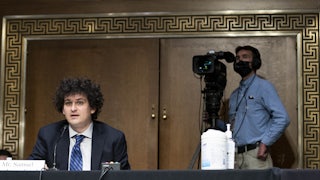Sam Bankman-Fried wants people to think he was the victim. The ex-billionaire who founded FTX, the now-failed crypto exchange, planned to tell Congress on Tuesday that he was “sorry” and that he had “fucked up.” But Bankman-Fried also apparently wanted pity and sympathy for his own downfall.
“Last year, my net worth was valued at $20 billion,” he wrote in remarks prepared for the House Financial Services Committee. “Today, I would be wrong to say that I have nothing: I have a loving family, and food on my plate, and that’s more than life has given to billions of people. But last I saw, I believe my bank account had about $100,000 in it.” The heart weeps.
Bankman-Fried’s many statements of contrition in the remarks read at times more like humblebrags than genuine remorse. He noted his “strong work ethic” at one point, lamenting that he used to work 18-hour days but worked “about 30 percent less” when things went awry. He complained that John Ray, the new CEO brought in to oversee FTX’s bankruptcy proceedings, wouldn’t answer his emails. He blamed a rival crypto exchange’s CEO for triggering FTX’s collapse in the first place. He even claimed that a coterie of outside lawyers and internal advisers had somehow compelled him to hand over FTX to Ray and file for bankruptcy despite purported financing offers from unnamed third parties to keep the company afloat.
Fortunately for lawmakers, Congress was spared the grueling experience of hearing firsthand from this tragic hero laid low by conniving executives, crypto rivals, and his own Homeric flaws. Bahamian officials arrested Bankman-Fried at the request of the Justice Department on Tuesday so that he can be extradited back to the United States to face charges for a medley of white-collar crimes. The Securities and Exchange Commission also brought civil charges against him, alleging that he had systematically defrauded investors while running FTX.
“FTX operated behind a veneer of legitimacy Mr. Bankman-Fried created by, among other things, touting its best-in-class controls, including a proprietary ‘risk engine,’ and FTX’s adherence to specific investor protection principles and detailed terms of service,” Gurbir Grewal, the director of the SEC’s enforcement division, said in a statement on Tuesday. “But as we allege in our complaint, that veneer wasn’t just thin, it was fraudulent.” SEC Chair Gary Gensler described FTX as a “house of cards built on a foundation of deception.”
Taken together, the two government actions show that Bankman-Fried was not simply inept and misguided but brazenly negligent and recklessly self-serving. The Justice Department’s 14-page indictment is somewhat bare-bones, which isn’t unusual at this early stage of a prosecution, but the broad outlines are still apparent. It charged Bankman-Fried with multiple counts of wire fraud, conspiracy to commit commodities fraud and securities fraud, and a lone count of campaign finance violations. Bankman-Fried was a prolific donor to Democratic and Republican candidates ahead of this year’s midterm elections.
Far more detail came from the SEC’s civil complaint against Bankman-Fried on Wednesday. Like the indictment, it centers on FTX’s relationship with Alameda Research, a crypto hedge fund also privately owned by Bankman-Fried. Some aspects of this relationship were publicly known beyond the ownership. Alameda, for example, served as a market maker for FTX and supposedly helped provide it with day-to-day liquidity. And it was public knowledge that Alameda also engaged in a variety of high-risk trading strategies for various cryptocurrencies.
What wasn’t publicly known—or, for the SEC’s purposes, disclosed to FTX investors—was that Bankman-Fried had funneled billions in FTX customer funds to Alameda to allow it to make risky bets on the crypto market. As long as crypto did well, the scheme could continue apace. The SEC alleged that Bankman-Fried went even further and used FTX customer funds via Alameda “as his personal piggy bank to buy luxury condominiums, support political campaigns, and make private investments, among other uses.”
“There was no meaningful distinction between FTX customer funds and Alameda’s own funds,” the SEC alleged in its complaint. “Bankman-Fried thus gave Alameda carte blanche to use FTX customer assets for its own trading operations and for whatever other purposes Bankman-Fried saw fit.” Bankman-Fried has claimed during his whirlwind post-collapse media tour that FTX had simply made a series of accounting mistakes, improperly tabulated its various assets and liabilities, and had not sufficiently hedged its positions. You know, the kind of errors that any crypto exchange run by a rookie CEO who got too busy trying to make the world a better place might make.
The SEC’s version of events is somewhat less breezy. It alleged that FTX’s trading platform had been explicitly designed to give Alameda an end run around normal trading safeguards: The hedge fund could run a negative balance on its FTX account, which effectively doubled as a line of credit based on customer funds, and was excluded from collateral requirements for margin trades that would automatically close the account if its liabilities grew too much. According to the SEC, Bankman-Fried personally directed FTX employees to encode these exemptions into the trading platform’s software.
At the same time that Alameda was playing around with FTX customer funds, Bankman-Fried and his top employees were telling anyone who would listen—a group including but not limited to investors in FTX itself—that FTX was the safe and “conservative” trading platform in the often risk-abundant crypto space. He touted the company’s automated “risk engine,” an algorithm that continually tracked and adjusted margin and collateral requirements to customer portfolios, to potential regulators like the Commodity Futures Trading Commission, which Bankman-Fried apparently preferred as a crypto watchdog to the SEC. (One can now see why.) And he sought to position himself as a reasonable, safe, and regulation-friendly crypto leader in the halls of power in Washington. All of it, the SEC’s complaint suggests, was built on the backs of misappropriated customer funds.
Like all great schemes, this one worked right up until it didn’t. Bernie Madoff managed to keep his $60 billion Ponzi scheme afloat for at least two decades before the 2008 market crash effectively froze the credit markets he had relied upon to keep it going. For Bankman-Fried, the end began when the crypto markets began spiraling downward this spring and various crypto firms collapsed over the summer. Instead of shoring up FTX’s position, he apparently began to double down on it.
“[Bankman-Fried] continued to spend hundreds of millions of dollars to purchase and support other crypto companies, and allowed Alameda to use FTX customer funds to repay its debts,” the SEC claimed in its complaint. “In addition, Bankman-Fried and other FTX executives continued to withdraw customer funds in the form of the poorly documented and undisclosed ‘loans’ described above. Specifically, on or about July 22, 2022, Bankman-Fried loaned himself $136 million. When he made this loan, Bankman-Fried knew, or was reckless in not knowing, of the significant financial risk it posed to both Alameda and FTX.” How he went from loaning himself $136 million to purportedly only having $100,000 in his checking account is unclear.
Things finally derailed when FTX sought and failed to obtain a buyout from the crypto trading platform Binance in November and declared bankruptcy a few days later. In his prepared remarks for Congress, Bankman-Fried blamed longtime personal rival Binance CEO Changpeng Zhao for precipitating FTX’s downfall by selling off Binance’s stake in a FTX crypto token and launching a campaign of “sustained negative PR” against FTX that triggered a “run on the bank.” Even if one were to take that as true, however, it is not Binance’s fault that when FTX’s customers ran to said bank, they found out that their funds had been given over to Alameda and subsequently vanished.
Bankman-Fried apparently believed, at least before yesterday, that he could mount a comeback of sorts. His prepared statement for Congress spends ample time attacking John Ray, Binance, and the FTX Chapter 11 process, as well as nursing various other grievances. He occasionally suggests that funding from some unspecified savior could still make everything right. That looks fairly unlikely now. If the SEC prevails, it will seek to permanently ban Bankman-Fried from participating in the securities markets, including crypto. And if the Justice Department secures a conviction against him on some or all of the fraud charges, crypto markets will be the least of his concerns. All it has to do now is persuade jurors that he was not just foolish but also fraudulent. So far, it has a pretty good case for both.






